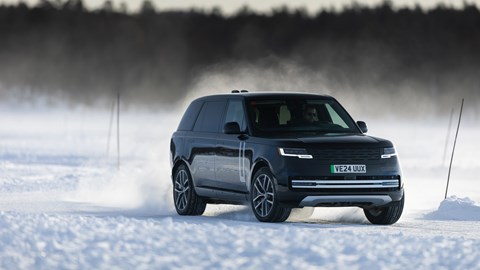► Range Rover EV prototype passenger ride
► Set to cost from £170k and weigh 2.8 tonnes
► 300-mile real-world range, 117kWh battery and 542bhp
Range Rover has gone electric. It’s been a long-time coming, but the British brand has finally made an EV version of its flagship SUV. In a year when even Ferrari is set to announce its first electric vehicle, Range Rover’s latest model comes not a moment too soon and looks set to build on the 140,000 (including Sport) models shifted each year.
As well as gathering key early details, we’ve also been for a passenger ride in a prototype version of the Range Rover Electric and seen what it can do during winter testing in Northern Sweden. Keep reading for everything you need to know about the new Range Rover Electric.

‘It’s a Range Rover first, EV second.’ That’s the internal party line, anyway. According to Thomas Müller, JLR’s product engineering boss, the EV version doesn’t replace anything—it complements it. ‘The customers should choose the best powertrain for a Range Rover that he or she wants to drive’.
However, both Müller and Vehicle Engineering Director Matt Becker claim it’s their top pick from the lineup. Why? Because the electric powertrain’s smoothness and serenity match the luxury character more naturally than a thumping V8 ever could.
Range Rover isn’t planning an all-out migration to battery power just yet, though. With 80% of current buyers living in regions not facing imminent combustion bans, the Range Rover Electric is an addition, not a revolution. And yes, petrol and diesel versions are sticking around.
In classic Range Rover fashion, the Electric version doesn’t look like it’s trying too hard. Visually, it’s 99% identical to its ICE siblings, right down to the MLA platform and production line in Solihull. Müller puts it plainly: ‘People buy Range Rover because it’s a Range Rover. They won’t buy it just because, first of all, it’s electric.’
The most noticeable styling difference is likely to be around the front grille where the differences in cooling requirements between EV and ICE means a revised design is possible. However, it’s worth noting that on our prototype car a 3D printed placeholder was used before the design is finalised.

We joined Becker at JLR’s winter testing facility for a sideways jaunt across a snow-packed handling circuit, and despite its expected 2.8-tonne kerb weight, the Range Rover Electric (on all-season tyres) acquitted itself admirably.
The centre of gravity is a good 50–60mm lower than the V8 Range Rover, meaning it can run with softer anti-roll bars and remain composed. Dual-rate springs, revised damper valving, and anticipatory software all keep it flat and balanced—even during the heavy acceleration granted by 627lb ft of torque.
Range Rover is tight-lipped on the final spec, but we know a few tasty figures: 542bhp, 117kWh usable battery, 300-mile range, 0–62mph in around 4.5 seconds. Expect a starting price similar to the V8 at around £170,000.
Underneath, two electric motors (having four would be less efficient, heavier and not as effective) drive both axles, using clever torque vectoring logic to manage grip. JLR’s Integrated Traction Management (ITM) can respond to slip in 50 milliseconds—around 100x faster than a traditional system.

We saw this in action up a steep slope where the right-hand side wheels were on ice and the left-hand side on tarmac. Despite having almost zero grip on one side, the car was able to claw its way up, managing traction across all four wheels. Admittedly, a petrol Range Rover could deliver similar end results, but the ease of use and control granted by faster responding electric drive units was hugely impressive.
In summary, early impressions suggest Range Rover has done a fine job taking its halo model into the age of electric. The execution appears well thought out and the engineers are right in that the level of serenity and quiet (afforded by the EV powertrain) does work beautifully with the car’s luxurious character.
If the price tag is indeed around the £170k mark, customers will however have a straight choice – V8 petrol or full EV. And in that respect, our only concern would be whether the electric powertrain feels special enough to warrant its price tag. After all, it’s easy to sell the benefits of a V8 over a regular engine, but much more of a task to differentiate a premium EV powertrain.
Keep an eye out for our first drive of the Range Rover Electric later this year.